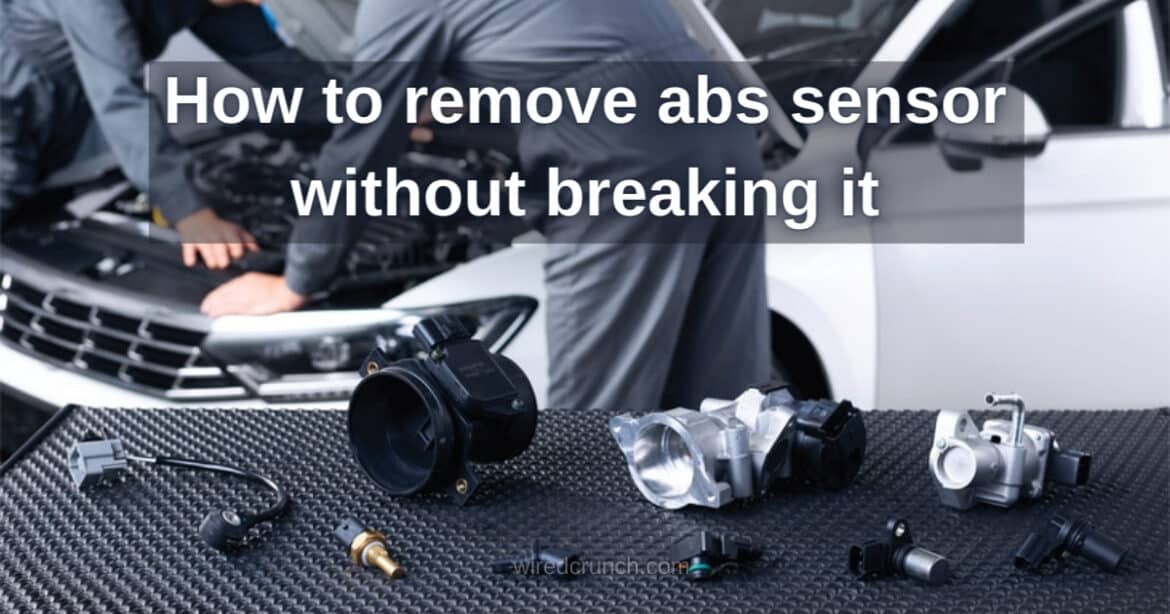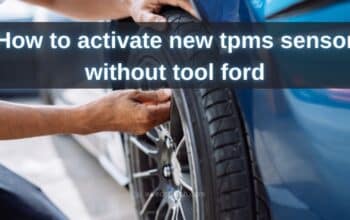You’re driving down the road when the antilock brake system (ABS) warning light suddenly pops up on the dashboard. Although an illuminated ABS light can mean many things, the most common cause is usually a faulty ABS sensor. The good news is that replacing an ABS sensor is often a straightforward task. In most cases, you only need a jack, jack stands, and basic hand tools.

However, knowing How to remove abs sensor without breaking it is crucial to avoid further issues and ensure a smooth replacement process. Let’s dive into the safe ABS sensor removal techniques to safely and effectively remove an ABS sensor.
Table of Contents
What is an ABS Sensor?
An ABS (Anti-lock Braking System) is an enhanced braking system commonly found in newer automobiles. An ABS sensor, also known as the wheel speed sensor or ABS brake sensor, measures the rotational speed of a wheel and sends this information to the car’s Engine Control Module (ECM). The ECM uses the data from all four ABS sensors to determine if any wheels are locking up, as they do not all turn at the same speed.
The ABS engages quicker than manual brakes and may emit a grinding noise in some cars. To remove ABS sensor safely, gently wiggle the sensor to loosen it and carefully pull it out, ensuring you do not apply excessive force.

What does the ABS sensor do?
The ABS sensor is a crucial component in modern vehicles. What does the ABS sensor do? It monitors the wheel’s speed and rotation to optimize both brake and traction control via the ABS. Typically installed at the wheel, it consists of two parts: a reluctor wheel or tone ring positioned on the axle, which rotates with the wheel, and a magnetic or hall effect sensor that sends the data to the ABS control module.
The wheel speed information is utilized to decide when to engage the ABS and to regulate the amount of pressure required to halt the vehicle safely without causing the brakes to lock up. This information is also shared with other systems, such as the engine, transmission, navigation, and chassis control systems.

Symptoms of a Bad ABS Sensor
If a wheel speed sensor is faulty, you will usually notice these symptoms:
- The ABS warning light turns on.
- Fault codes, like P0500, are stored in the vehicle’s OBDII system.
- The wheels lock up during braking.
- Other systems fail to respond to the sensor readings.

How to remove abs sensor without breaking it?
Removing an ABS sensor without breaking it requires careful steps. Here is how to remove ABS sensor without breaking it:
First, turn off the car and disconnect the battery for safety. Then, locate the ABS sensor near the wheel hub or axle. Clear the area surrounding the sensor to eliminate any dirt or debris. Next, unscrew the bolts or screws holding the sensor in place using the right tools. Gently wiggle the sensor to loosen it, being careful not to use too much force.

Once the sensor is loose, carefully pull it straight out from its socket. Finally, inspect the sensor and connector for any damage before reinstalling or replacing it.
Troubleshooting the ABS Sensor
To find the source of any sensor faults, follow these steps:
- Connect a diagnostic tool to record fault codes and check the live data parameters for the ABS sensor.
- Use a multimeter and oscilloscope to check supply voltages and signals. Measure the sensor connector to test the whole line between the control unit and the sensor.
- Inspect the sensor connectors and wiring to ensure they are correctly positioned, secured, and free of damage or contamination.
- Check the sensor and impulse ring for any damage.
- If there is dirt, use a wire brush to clean the contact surface.

Common Fault Codes of ABS Sensor
Common fault codes and their causes include:
- C0060: Left front ABS solenoid 1 circuit malfunction
- C0065: Left front ABS solenoid 2 circuit malfunction
- C0070: Right front ABS solenoid 1 circuit malfunction
- C0075: Right front ABS solenoid 2 circuit malfunction
- C0080: Left rear ABS solenoid 1 circuit malfunction
- C0085: Left rear ABS solenoid 2 circuit malfunction
- C0090: Right rear ABS solenoid 1 circuit malfunction
- C0095: Right rear ABS solenoid 2 circuit malfunction
Replacing a faulty ABS sensor
When dealing with a faulty ABS wheel sensor, here is the replacement process to expect:
- Diagnostic Scan: An automotive professional will use specialized tools to identify the problematic sensor and verify the issue.
- Lift and Wheel Removal: The vehicle will be lifted, and the respective wheel will be removed to access the sensor.
- Sensor Detachment: The old sensor will be detached from its mount, often secured by screws.
- New Sensor Installation: The new sensor will be carefully installed and secured.
- Wheel Reinstallation: After ensuring everything is in order, the wheel will be reinstalled.
- Test Drive and Calibration: A test drive will be conducted to verify the sensor’s proper functioning. If needed, calibration will be performed.

Avoiding Future Issues
Taking proactive steps can help extend the life of your ABS wheel sensors:
- Regular Cleaning: Keep your wheel sensors clean and free from debris.
- Rust Protection: Apply protective sprays to prevent corrosion on sensor connections.
- Safe Driving: Avoid rough driving, especially over potholes and obstacles.
Conclusion
Removing an ABS sensor without breaking it requires patience and careful handling. Ensure you have the right tools and follow the proper steps to avoid damaging the sensor or its components. By taking your time and being gentle, you can successfully remove the ABS sensor and keep it intact for reuse or replacement.
Frequently Asked Questions (FAQs)
Can I unplug my ABS sensor?
On most vehicles, this is not an issue, but on some notably pickup trucks this can lead to a lack of stability under heavy braking as the rear brakes lock up early. If unplugging the sensor makes your problem go away, don’t be fooled. You’ve simply disabled the entire ABS, masking the symptoms.
What happens if you disconnect ABS sensor?
Unfortunately, you need to use a scan tool that can handle the ABS. By disconnecting the sensor the computer most likely thinks there is a problem so it is putting the vehicle into a safe mode. Clearing the codes with a scan tool is the only way to resolve this.
how long do abs sensors last?
How Often Does an ABS Sensor Need to be Replaced? ABS sensors are designed to last for the life of the vehicle, but they can still become damaged or fail over time. It is recommended to have the ABS inspected regularly during routine maintenance to ensure proper function.
What can damage ABS sensor?
It is often one or more sensors or the wiring to the sensors. The most common ABS problems occur when sensors become contaminated with debris or metal shavings. Malfunctions also occur when sensor wiring becomes damaged, resulting in intermittent or no continuity.
How do you bypass an ABS sensor?
Unplug the module, but then you will get fault codes. Now it is also possible to bypass the whole unit completely. But you would have to totally re-plumb the brake lines. Maybe even have to add a proportioning or metering valve. The amount of work needed to do this is very high and also this CAN be dangerous depending on driving conditions. No matter what you do, you will get fault codes!!!
READ MORE :
How Long Can You Drive With a Bad Crankshaft Sensor
I have a professional background with a Diploma in Information Communication Technology, which brings a blend of technical expertise and creative flair to my writing. Currently, I serve as a writer for Creativeoutrank LLC and contribute to their various websites.
I’m writing is a ref... Read more



